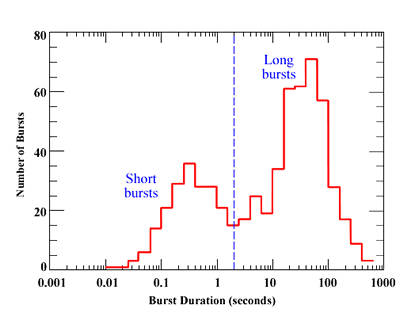Gamma Ray Burst Progenitors

The Burst and Transient Source Experiment on board the Compton Gamma Ray Observatory discovered two very important characteristics of gamma ray bursts (GRBs). It showed that these bursts were distributedly homogeneously over the whole sky, and that if the number of bursts was plotted against the duration of the burst, there were two distinct populations. Those that lasted less than 2 seconds were given the name short bursts, while those with longer durations were called, not surprisingly, long bursts.
Most astronomers now agree that long bursts and short bursts appear to be fundamentally different, and although debate still rages as to the progenitors of short bursts in particular, the current idea is the following:
Long Bursts
There is almost unanimous agreement that long bursts are the result of a hypernova, a powerful supernova that occurs when a massive, rapidly rotating star collapses to a black hole. Convincing evidence to support this supernova-GRB connection comes from the rebrightening of optical transients at late times (attributed to the emergence of an underlying supernova light curve), and the evolution of the spectrum of the afterglow of GRB030329. This was observed to change from the power-law decline typical of optical transients to a supernova spectrum with broad peaks and troughs.
Short Bursts
While there is general consensus on the progenitors for long bursts, the origin of short bursts remains an open question. Astronomers believe that a different progenitor system is involved in the production of these bursts since they tend to be a factor of 10 dimmer than long bursts, and emit more highly-energetic (hard) gamma rays. An additional constraint is that the hypernova model in its current formulation cannot produce bursts of less than 2 seconds.
The most widely accepted theory at present is that short bursts are produced by the merger of two closely orbiting neutron stars. These neutron stars lose orbital energy by emitting gravitational waves, a process which causes them to spiral towards each other. Due to their high combined mass, the merger results in an immediate collapse into a black hole and the emission of gamma rays.
Study Astronomy Online at Swinburne University
All material is © Swinburne University of Technology except where indicated.

